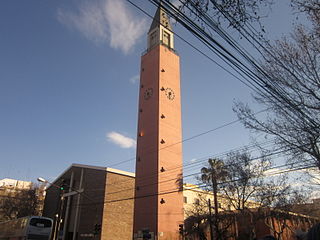
The Metropolitan Cathedral of Sucre, also called Cathedral Basilica of Our Lady of Guadalupe is a cathedral of Sucre, formerly La Plata, Bolivia is the seat of the Roman Catholic Church in Bolivia. It was built between 1559 and 1712. [1]

The Metropolitan Cathedral of Sucre, also called Cathedral Basilica of Our Lady of Guadalupe is a cathedral of Sucre, formerly La Plata, Bolivia is the seat of the Roman Catholic Church in Bolivia. It was built between 1559 and 1712. [1]
Juan de Araujo, was maestro de capilla of the Cathedral of La Plata 1680–1712, training up four important criollo composers: Andrés Flores, Sebastián de los Ríos, Roque Jacinto de Chavarría, and Blas Tardío y Guzmán who himself was maestro from 1745.[ citation needed ]

Sucre is the de jure capital city of Bolivia, the capital of the Chuquisaca Department and the sixth most populous city in Bolivia. Located in the south-central part of the country, Sucre lies at an elevation of 2,790 m (9,150 ft). This relatively high altitude gives the city a subtropical highland climate with cool temperatures year-round. Over the centuries, the city has received various names, including La Plata, Charcas, and Chuquisaca. Today, the region is of predominantly Quechua background, with some Aymara communities and influences.

Fray Thomas de San Martín was the founder of the National University of San Marcos in Lima, Peru, a notable Spanish scholar, and was appointed the first Bishop of La Plata o Charcas (1552–1559).

Mizque, Misk'i is a town in the Cochabamba Department, Bolivia. It is the capital of the Mizque Province. Mizque is located in the valley of the Mizque River, one of the main tributaries of the Río Grande.
The Real Audiencia of Charcas was a Spanish audiencia with its seat in what is today Bolivia. It was established in 1559 in Ciudad de la Plata de Nuevo Toledo and had jurisdiction over the Governorate of Charcas, Paraguay and the Governorate of the Río de la Plata. The audiencia oversaw the incredible silver output of the mines at Potosí. It was part of the Viceroyalty of Peru until 1776, when it was transferred to the newly created Viceroyalty of the Río de la Plata and began to be referred to as Upper Peru.

The Roman Catholic Archdiocese of Santa Cruz de la Sierra is an ecclesiastical territory or diocese of the Roman Catholic Church in Bolivia. It was erected as the Diocese of Santa Cruz de la Sierra by Pope Paul V on July 5, 1605, and was elevated to the rank of a metropolitan archdiocese by Pope Paul VI on July 30, 1975, with the suffragan see of San Ignacio de Velasco.
Jácaras are Spanish songs which are accompanied with instruments and are performed during the entr'acte of a theatrical performance and also as an accompaniment to many types of dance.

The National Mint of Bolivia or the Mint of Potosí is a mint located in the city of Potosí in Bolivia. It is from this mint that most of the silver shipped through the Spanish Main came.

The Roman Catholic Archdiocese of Cochabamaba is an archdiocese located in the city of Cochabamba in Bolivia.

The Roman Catholic Archdiocese of Sucre is an archdiocese located in the city of Sucre in Bolivia.

The Roman Catholic Archdiocese of La Paz is an archdiocese located in the city of La Paz in Bolivia.

Juan de Araujo (1646–1712) was a musician and composer of the Early to Mid Baroque.
Blas Tardío de Guzmán was a Bolivian criollo composer, one of four notable criollo students of Juan de Araujo. He succeeded Juan Guerra y Biedma as chapelmaster, maestro de capilla, of the Cathedral of Sucre, then called La Plata, in 1745.
Roque Ceruti was an Italian composer in Peru. He was recruited as conductor of the Viceroy of Peru's private orchestra, and was a dominant italianizing influence during the period, though this was resented by some of the more traditional Spanish musicians.
Juan Queipo de Llano y Valdés (1635–1713) was a Roman Catholic prelate who served as Archbishop of La Plata o Charcas (1680–1694) and Bishop of La Paz (1694–1713).

San Juan Cathedral, dedicated to Saint John the Baptist, is a cathedral and parish of the Roman Catholic Church in San Juan, Argentina. It is the seat of the metropolitan bishop of the Roman Catholic Archdiocese of San Juan de Cuyo.
Alonso Ramírez Vergara, O.S. was a Roman Catholic prelate who served as Bishop of La Plata o Charcas (1594–1602).

The architecture of Bolivia is closely related to its history, culture and religion. Bolivian architecture has been constantly changing and progressing over time. Subject to terrain and high altitudes, most of Bolivia's Pre-Columbian buildings were built for housing, mainly influenced by Bolivian indigenous culture. The arrival of Spanish settlers brought many European-style buildings, and the Spaniards began planning to build big cities. After Independence, the architectural style became Neoclassical and many churches and government buildings were built. In modern Bolivia, like many countries, skyscrapers and post-modern buildings dominate, and of course there are special styles of architecture to attract tourists and build.
The corregimiento de Potosí was a territorial entity of the Spanish Empire in the Viceroyalty of Peru, located in what is now the territory of Bolivia. The position of corregidor was not an accessory of the President of the Real Audiencia of Charcas, it fell to various people. The corregidor resided alternately in La Plata and in Potosí. In the 18th century, it became the Government of Potosí.
Gutierre Fernández, sometimes given as Gutierre Fernández Hidalgo, was a South American composer and Roman Catholic priest of Spanish birth. His only surviving works are sacred vocal works; most of which were composed for vespers.
19°02′55″S65°15′37″W / 19.04861°S 65.26028°W